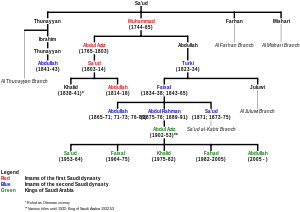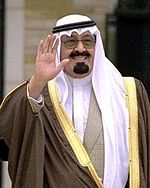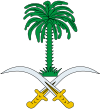- House of Saud
-
"Saud" redirects here. For the Pakistani actor, see Saud (actor). For the Romanian village of Săud, see Bunteşti.
House of Saud 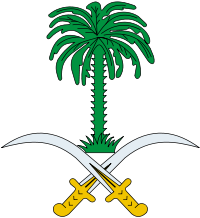
Country Diriyah, Najd and Saudi Arabia Titles - King of Saudi Arabia
- Custodian of the Two Holy Mosques
Current head Abdullah Founding 1744—Muhammad ibn Saud The House of Saud (Arabic: آل سعود Āl Suʻūd), also called the Al Saud, is the ruling royal family of Saudi Arabia and one of the wealthiest and most powerful dynasties in the world. The family holds thousands of members. It is composed of the descendants of Muhammad ibn Saud and his brothers, though the ruling faction of the family is primarily led by the descendants of Abdulaziz ibn Abdul Rahman Al Saud. The family advocates Salafi Islam and unification of Arabia.[1]
The most influential member of the family is the King of Saudi Arabia. The line of succession to the Saudi throne is not father-son but brother-brother of the children of King Abdul-Aziz. The family is estimated to be composed of 7,000 members.[2][3] Most power resides amongst the 200 or so descendants of King Abdul-Aziz.
The House of Saud has gone through three phases: the First Saudi State, the Second Saudi State, and the modern nation of Saudi Arabia. The First Saudi State marked the expansion of Salafi Islam. The Second Saudi State was marked with continuous infighting. The modern nation of Saudi Arabia wields considerable influence in the Middle East. The family has had conflicts with the Ottoman Empire, the Sharif of Mecca, and the Al Rashid family of Ha'il.
Contents
Title
House of Saud is a translation of Al Saud. The latter is an Arabic dynastic name formed by adding the word Al, meaning "family of" or "House of",[4] to the personal name of an ancestor. In the case of the Al Saud, this is the father of the dynasty's 18th century founder, Muhammad ibn Saud (Muhammad, son of Saud).[5]
Today, the surname "Al Saud" is carried by any descendant of Muhammad ibn Saud or his three brothers Farhan, Thunayyan, and Mishari. Al Saud's other family branches are called cadet branches. Members of the cadet branches hold high and influential positions in government though they are not in line of succession to Saudi throne. Many cadet members intermarry within the Al Saud to reestablish their lineage and continue to wield influence in the government.
Sons and grandsons of King Abdul-Aziz are referred to in the style "His Royal Highness" (HRH), differing from the royals belonging to the cadet branches which are called "His Highness" (HH).
History
Origins and early history
The earliest recorded ancestor of the Al Saud was Mani' ibn Rabiah Al-Muraydi. He settled in Diriyah in 1446–7 with his clan, the Mrudah. Mani was invited by a relative named Ibn Dir. Ibn Dir was the ruler of a set of villages and estates that make up modern-day Riyadh. Mani's clan had been on a sojourn in east Arabia, near al-Qatif, from an unknown point in time. Ibn Dir handed Mani two estates called al-Mulaybeed and Ghusayba. Mani and his family settled and renamed the region "al-Diriyah", after their benefactor Ibn Dir.[6][7]
The Mrudah became rulers of al-Diriyah, which prospered along the banks of Wadi Hanifa and became an important Najdi settlement. As the clan grew larger, power struggles ensued, with one branch leaving to nearby Dhruma, while another branch (the "Al Watban") left for the town of az-Zubayr in southern Iraq. The Al Migrin became the ruling family among the Mrudah in Diriyah.
After some initial struggles in the early 18th century, Muhammad ibn Saud, of the Al Migrin, became the undisputed Amir. In 1744, Muhammad took in fugitive religious cleric named Muhammad ibn Abdul-Wahhab from nearby al-Uyayna. Muhammad ibn Saud agreed to provide political support to Ibn Abdul-Wahhab's project to reform Islamic practice. This marked the beginning of the First Saudi State.
First Saudi State
Main article: First Saudi State Flag of the First Saudi State
Flag of the First Saudi State
The First Saudi State was founded in 1744. This period was marked by conquest of neighboring areas and by religious zeal. At its height, the First Saudi State included most of the territory of modern-day Saudi Arabia, and raids by Al Saud's allies and followers reached into Yemen, Oman, Syria, and Iraq. Islamic Scholars, particularly Muhammad ibn Abdul-Wahhab and his descendants, are believed to have played a significant role in Saudi rule during this period. The Saudis and their allies referred to themselves during this period as the Muwahhidun or Ahl al-Tawhid ("the monotheists"), so later they are referred as the Wahhabis.
Leadership of the Al Saud during the time of their first state passed from father to son without incident. The first imam, Muhammad ibn Saud, was succeeded by his eldest son Abdul-Aziz in 1765. Abdul-Aziz was killed in 1803 by an assassin, believed by some to have been a Shi'ite seeking revenge over the sacking of the Shi'ite holy city of Karbala by Saudi loyalists in 1802. Abdul-Aziz was in turn succeeded by his son, Saud, under whose rule the Saudi state reached its greatest extent. By the time Saud died in 1814, his son and successor Abdullah had to contend with an Ottoman-Egyptian invasion seeking to retake lost Ottoman territory and destroy the call to return to pure Islam[dubious ]. The mainly Egyptian force succeeded in defeating Abdullah's forces, taking over the Saudi capital of Diriyyah in 1818. Abdullah was taken prisoner and was soon beheaded by the Ottomans in Constantinople, putting an end to the First Saudi State. The Egyptians sent many members of the Al Saud clan and other members of the local nobility as prisoners to Egypt and Constantinople, and proceeded to raze the Saudi capital of Diriyyah.
Second Saudi State
Main article: Second Saudi State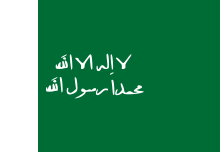 Flag of the Second Saudi State
Flag of the Second Saudi State
A few years after the fall of Diriyyah in 1818, the Saudis were able to re-establish their authority in Najd, establishing what is now commonly known as the Second Saudi State, with its capital in Riyadh.
Compared to the First Saudi State, the second Saudi period was marked by less territorial expansion (it never reconquered the Hijaz or 'Asir, for example) and less religious zeal, although the Saudi leaders continued to go by the title of imam and still employed Salafi religious scholars. The second state was also marked by severe internal conflicts within the Saudi family, eventually leading to the dynasty's downfall. In all but one instance succession occurred by assassination or civil war, the exception being the passage of authority from Faisal ibn Turki to his son Abdullah ibn Faisal ibn Turki.
The first Saudi to attempt to regain power after the fall of Dir'iyyah in 1818 was Mishari ibn Saud, a brother of the last ruler in Dir'iyyah. Mishari was soon captured by the Egyptians and killed. In 1824, Turki ibn Abdullah, another Saudi who had managed to evade capture by the Egyptians, was able to expel Egyptian forces and their local allies from Riyadh and its environs. Turki, a grandson of the first Saudi imam Muhammad ibn Saud, is generally regarded as the founder of the second Saudi dynasty and is also the ancestor of the kings of modern-day Saudi Arabia. He made his capital in Riyadh and was able to enlist the services of many relatives who had escaped captivity in Egypt, including his son Faisal.
Turki was assassinated in 1834 by Mishari ibn Abdul-Rahman, a distant cousin. Mishari was soon besieged in Riyadh and later executed by Turki's son, Faisal, who went on to become the most prominent ruler of the Saudis' second reign. Faisal, however, faced a re-invasion of Najd by the Egyptians four years later. The local population was unwilling to resist, and Faisal was defeated and taken to Egypt as a prisoner for the second time in 1838.
The Egyptians installed Khalid ibn Saud as ruler in Riyadh and supported him with Egyptian troops. Khalid was the last surviving brother of the last imam of the First Saudi State, and had spent many years in the Egyptian court. In 1840, however, external conflicts forced the Egyptians to withdraw all their presence in the Arabian Peninsula, leaving Khalid with little support. Seen by most locals as nothing more than an Egyptian governor, Khalid was toppled soon afterwards by Abdullah ibn Thuniyyan, of the collateral Al Thuniyyan branch. Faisal, however, had been released that year, and, aided by the Al Rashid rulers of Ha'il, was able to retake Riyadh and resume his rule. Faisal later appointed his son Abdullah as crown prince, and divided his dominions between his three sons Abdullah, Saud, and Muhammad.
Upon Faisal's death in 1865, Abdullah assumed rule in Riyadh but was soon challenged by his brother, Saud ibn Faisal. The two brothers fought a long civil war, in which they traded rule in Riyadh several times. Previously a vassal of the Saudis, Muhammad ibn Abdullah ibn Rashid of Hail took the opportunity to intervene in the conflict and increase his own power. Gradually, Ibn Rashid extended his authority over most of Najd, including the Saudi capital, Riyadh. Ibn Rashid finally expelled the last Saudi leader, Abdul-Rahman bin Faisal, from Najd after the Battle of Mulayda in 1891.
Saudi Arabia
Main articles: Unification of Saudi Arabia and Saudi ArabiaSaudi Arabia 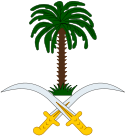
This article is part of the series:
Politics and government of
Saudi ArabiaConstitutionMonarchy- House of Saud
- King
- Crown Prince
- Allegiance Council
Government- Legal system
- Human rights
- Women's rights
- LGBT rights
- Freedom of religion
- Capital punishment
DivisionsForeign policy
After his defeat at Mulayda, Abdul-Rahman ibn Faisal went with his family into exile in the deserts of eastern Arabia among the Al Murra bedouin. Soon afterward, however, Abdul-Rahman found refuge in Kuwait as a guest of the Kuwaiti emir, Mubarak Al Sabah. In 1902, Abdul-Rahman's son, Abdul-Aziz, took on the task of restoring Saudi rule in Riyadh. Supported by a few dozen followers and accompanied by some of his brothers and relatives, Abdul-Aziz was able to capture Riyadh's Masmak fort and kill the governor appointed there by Ibn Rashid. Abdul Aziz, reported to have been barely 20 at the time, was immediately proclaimed ruler in Riyadh. As the new leader of the House of Saud, Abdul-Aziz became commonly known from that time simply as "Ibn Saud".
Ibn Saud spent the next three decades trying to re-establish his family's rule over as much of the Arabian Peninsula as possible, starting with his native Najd. His chief rivals were the Al Rashid clan in Ha'il, the Sharifs of Mecca in the Hijaz, and the Ottoman Turks in al-Hasa. Ibn Saud also had to contend, however, with the descendants of his late uncle Saud ibn Faisal (later known as the "Saud al-Kabir" branch of the family), who posed as the rightful heirs to the throne. Though for a time acknowledging the sovereignty of the Ottoman Sultans and even taking the title of pasha, Ibn Saud allied himself to the British, in opposition to the Ottoman-backed Al Rashid. For the period between 1915 and 1927, Ibn Saud's dominions were a protectorate of the British Empire, pursuant to the 1915 Treaty of Darin.
By 1932, Ibn Saud had disposed of all his main rivals and consolidated his rule over much of the Arabian Peninsula. He declared himself king of the Kingdom of Saudi Arabia that year. Previously, he had gone through several titles, starting with "Sultan of Najd" and ending with "King of Hijaz and Najd and their dependencies." Ibn Saud's father, Abdul Rahman retained the honorary title of "imam." A few years later, in 1937, American surveyors discovered near Dammam what later proved to be Saudi Arabia's vast oil reserves. Before the discovery of oil, many family members were destitute.[8]
Ibn Saud fathered dozens of sons and daughters by his many wives. He had at most only four wives at one time. He divorced and married many times. He made sure to marry into many of the noble clans and tribes within his territory, including the chiefs of the Bani Khalid, Ajman, and Shammar tribes, as well as the Al ash-Sheikh (descendants of Muhammad ibn Abd al-Wahhab). He also arranged for his sons and relatives to enter into similar marriages. He appointed his eldest surviving son, Saud as heir apparent, to be succeeded by the next eldest son, Faisal. The Saudi family became known as the "royal family," and each member, male and female, was accorded the title of amir or amira ("prince" or "princess"), respectively.
Ibn Saud died in 1953, after having cemented an alliance with the United States in 1945. He is still celebrated officially as the "Founder," and only his direct descendents may take on the title of "his or her Royal Highness." The date of his recapture of Riyadh in 1902 was chosen to mark Saudi Arabia's centennial in 1999 (according to the Islamic lunar calendar).
Upon Ibn Saud's death, his son Saud assumed the throne without incident, but his lavish spending led to a power struggle between him and the new crown prince, Faisal. In 1964, the royal family forced Saud to abdicate in favor of Faisal, aided by an edict from the country's grand mufti. During this period, some of Ibn Saud's younger sons, led by Talal ibn Abdul Aziz defected to Egypt, calling themselves the "Free Princes" and calling for liberalization and reform, but were later induced to return by Faisal. They were fully pardoned but were also barred from any future positions in government.
Faisal was assassinated in 1975 by a nephew, Faisal ibn Musaid, who was then promptly executed. Another brother, Khalid assumed the throne. The next prince in line had actually been Muhammad, but Muhammad had relinquished his claim to the throne in favor of Khalid, who was his only full brother.
Khalid died of a heart attack in 1982, and was succeeded by Fahd, the eldest of the powerful "Sudairi Seven", so-called because they were all sons of Ibn Saud's wife, Hassa al-Sudairi. Fahd did away with the previous royal title of "his Majesty" and replaced it with the honorific "Custodian of the Two Holy Mosques," in reference to the two Islamic holy sites in Mecca and Medina.
A stroke in 1995 left Fahd largely incapacitated, and the crown prince, Abdullah gradually took over most of the king's responsibilities until Fahd's death in August 2005. Abdullah was proclaimed king on the day of Fahd's death and promptly appointed his younger brother Sultan bin Abdul-Aziz, the minister of defense and Fahd's "Second Deputy Prime Minister," as the new heir apparent. Sultan passed away in October 2011. On March 27, 2009 Abdullah appointed Prince Naif Interior Minister as his "second deputy prime minister"
Political power
The Head of the House of Saud is the King of Saudi Arabia who serves as Head of State and monarch of the Kingdom of Saudi Arabia. The King holds almost absolute political power. The King appoints ministers to his cabinet who supervise their respective ministries in his name. The key ministries of Defense, the Interior, and Foreign Affairs are reserved for the Al Saud, as are most of the thirteen regional governorships. Most portfolios, however, such as Finance, Labor, Information, Planning, Petroleum Affairs and Industry, have traditionally been given to commoners, often with junior Al Saud members serving as their deputies. House of Saud family members also hold many of the Kingdom's critical military and governmental departmental posts. Ultimate power in the Kingdom has always rested upon the Al Saud, though support from the Ulema, the merchant community, and the population-at-large has been key to the maintenance of the royal family's political status quo.
Long term political and government appointments, such as those of King Abdullah, who has been Commander of the National Guard since 1963, Crown Prince Sultan, Minister of Defence & Aviation since 1962, Prince Mutaib Minister of Municipal & Rural Affairs from 1975 until his resignation in 2009, Prince Nayef who has been the Minister of Interior since 1975, and Prince Salman, who has been Governor of the Riyadh Region since 1962, have perpetuated the creation of fiefdoms where senior princes have, often, though not exclusively, co-mingled their personal wealth with that of their respective domains. They have often appointed their own sons to senior positions within their own fiefdom. Examples of these include Prince Mutaib bin Abdullah as Assistant Commander in the National Guard; Prince Khalid bin Sultan as Assistant Minister of Defence; Prince Mansour ibn Mutaib as Assistant Minister for Municipal & Rural Affairs until he replaced his father in 2009; and Prince Mohammed ibn Nayef as Assistant Minister in the Interior Ministry. In cases, where portfolios have notably substantial budgets, appointments of younger, often full, brothers have been necessary, as deputies or vice ministers, ostensibly to share the wealth and the burdens of responsibility, of each fiefdom. Examples of these include Prince Abdul Rahman who is Vice Minister of Defence & Aviation under Prince Sultan; Prince Badr, Deputy to King Abdullah in the National Guard; Prince Sattam, who is Deputy to Riyadh Governor, Prince Salman; and Prince Ahmed, who holds the Deputy Minister's portfolio in Prince Nayef's Interior Ministry.
Unlike Western royal families, the Saudi Monarchy has not had a clearly defined order of succession. Historically, upon becoming King, the monarch has designated an heir apparent to the throne who serves as Crown Prince of the Kingdom. Upon the King's death the Crown Prince becomes King, and during the King's incapacitation the Crown Prince, likewise, assumes power as regent. Though other members of the Al Saud hold political positions in the Saudi government, technically it is only the King and Crown Prince who legally constitute the political institutions.
Succession
Main article: Line of succession to the Saudi throneWealth
The sharing of family wealth has been a critical component in maintaining the semblance of a united front within the royal family. An essential part of family wealth is the Kingdom in its physical entirety, which the Al Saud view as a totally owned family asset. Whether through the co-mingling of personal and state funds from lucrative government positions, huge land allocations, direct allotments of crude oil to sell in the open market, segmental controls in the economy, special preferences for the award of major contracts, outright cash handouts, and astronomical monthly allowances—all billed to the national exchequer—all told, the financial impact may have exceeded 40% of the Kingdom's annual budget during the reign of King Fahd. Over decades of oil revenue-generated expansion, estimates of royal receipts have varied, ranging as low as $500 billion and as high as well over $1 trillion.[9] This method of wealth distribution has allowed many of the senior princes and princesses to accumulate largely unauditable wealth and, in turn, pay out, in cash or kind, to lesser royals and commoners, and thereby gaining political influence through their own largesse.
During periods of high oil prices as were the late 1970s, the early 1980s, and again, immediately after the 2003 US invasion of Iraq, national income has outpaced the developmental needs and social obligations of the Saudi government and the effects of royal skimming were diminished. According to well-publicized but unsubstantiated reports, King Abdullah has intentions to reduce the Al Saud share of the budget, an act which may sow discontent within the royal family, but would be popular with the Kingdom's citizenry.
Opposition to the House of Saud
Internal opposition
Due to its authoritarian and theocratic rule, the House of Saud has attracted much criticism during its rule of Saudi Arabia. Its opponents generally refer to the Saudi monarchy as totalitarians or dictators.
There have been numerous incidents of demonstrations and other forms of resistance against the House of Saud. These range from the Ikhwan uprising during the reign of Ibn Saud, to numerous coup attempts by the different branches of the Kingdom's military. On November 20, 1979 the Holy Sanctuary in Mecca was violently seized by a group of dissidents. The seizure was carried out by 500 heavily armed and provisioned Saudi dissidents, consisting mostly of members of the former Ikhwan tribe of Utayba[10] but also of other peninsular Arabs and a few Egyptians enrolled in Islamic studies at the Islamic University of Medina.
The seizure was led by Juhayman al-Otaibi and Muhammad ibn 'Abdallah al-Qahtani who cited the corruption and ostentatiousness of the ruling house of Saud. Utaybi and his group spoke against the socio–technological changes taking place in Saudi Arabia. Utaybi demanded that oil should not be sold to the United States.[11]
Utaybi received little mass support outside of small circles of workers and students of tribal origin, and foreign labourers (from Egypt, Yemen and Pakistan.) The Saudi royal family turned to the Ulema who duly issued a fatwa permitting the storming of the holy sanctuary. Saudi forces, aided by French and Pakistani special ops units, a different version of this said they were British special ops units, they were deputized Muslims for the operation, maybe I am confusing operations, took two weeks to flush the rebels out of the holy sanctuary; the use of French commandos was surprising since, officially, non-Muslims may not enter the city of Mecca.[12]
Saudi forces with the aid of Pakistani Special Services units ejected Utaybi’s Group. All surviving males (including Juhaiman ibn Muhammad ibn Saif al Utaybi) were beheaded publicly in four cities of Saudi Arabia.[13]
Heads of the House of Sa'ud
First Saudi state
- Muhammad ibn Saud (died 1765)
- Abdul-Aziz ibn Muhammad ibn Saud
- Saud ibn Abdul-Aziz ibn Muhammad Al Saud
- Abdullah ibn Saud
Second Saudi state
- Turki ibn Abdallah
- Faisal ibn Turki Al Saud (first period)
- Khalid ibn Saud (appointed by the Egyptians)
- Abdullah ibn Thunayyan
- Faisal ibn Turki (second period)
- Saud ibn Faisal ibn Turki
- Abdullah ibn Faisal
- Abdul-Rahman bin Faisal
Kingdom of Saudi Arabia
- King Abdul-Aziz ibn Abdul-Rahman Al Saud
- King Saud ibn Abdul-Aziz
- King Faisal ibn Abdul-Aziz
- King Khalid ibn Abdul-Aziz
- King Fahd ibn Abdul-Aziz
- King Abdullah ibn Abdul-Aziz
Most notable current members
Sons of King Abdul-Aziz
- Bandar bin Abdul-Aziz (born 1923) – Has never held a government post but considered close to King Abdullah. Religious, and possibly a recluse.
- Musaid bin Abdul-Aziz (born 1923) – His older son, Khalid, was killed in a shootout with police in the early 1960s while demonstrating against the Kingdom's introduction of television. His younger son, Faisal, was King Faisal's assassin a decade later, for which he was beheaded. Mus'aid is religious, eccentric and a recluse. King Abdullah visited him in a Riyadh hospital in March 2009.[14]
- Mishaal bin Abdul-Aziz (born 1926) – Former Minister of Defense & Governor of Makkah Province. Close confidant of King Abdullah, and Chairman of the Allegiance Council, Mishaal is one of the Kingdom's wealthiest royals with extensive interests in real estate and a wide range of business interests.
- Abdul-Rahman ibn Abdul-Aziz (born 1931) – Former Deputy Defense Minister from 1978 - 2011, ( relieved of this position November 5, 2011), after replacing younger brother, Turki in 1978, who was reportedly[by whom?] unfit for the position. Among the wealthiest royals[citation needed] with extensive business interests. With full brother, Crown Prince Sultan's recent death, and waning desire for greater power, Abdul-Rahman has reinforced his influence in the royal family, emerging as the preeminent member of the royal family's Sudairi faction.
- Mutaib ibn Abdul-Aziz (born 1931) – Minister for Municipal & Rural Affairs from 1975 until 2009, and former Governor of Makkah. His profile and influence have greatly increased due to a lengthy tenure in government and a long-standing family alliance with King Abdullah and his only surviving full brother, Mishaal.
- Talal ibn Abdul-Aziz (born 1931) – Has held the ministerial portfolios for Finance and Communications. Major businessman, special envoy to UNESCO and Chairman of AGFUND. May not be a contender for the throne[original research?] for his leading role in the Free Princes movement of 1958 which sought government reform. Father of Al-Waleed bin Talal.
- Badr bin Abdul-Aziz (born 1933) – Long-time Deputy Commander of National Guard. Participated in the Free Princes movement in 1958 and rehabilitated by King Faisal a decade later.
- Nawwaf bin Abdul-Aziz (born 1933) – Senior advisor of King Abdullah, former Minister of Finance and, briefly, Director General of the General Intelligence Directorate. Has substantial business holdings.
- Nayef bin Abdul-Aziz Al Saud (born 1933) – Crown Prince, First Deputy Prime Minister, and long-time powerful Minister of Interior.
- Turki II bin Abdul-Aziz Al Saud (born 1934) – Businessman after he was forced to resign as Deputy Minister of Defence in 1978.
- Abdulilah ibn Abdul-Aziz (born 1935) – Former Governor of Al Jawf Province. Appointed Special Advisor to King Abdullah in 2008.
- Salman bin Abdul-Aziz Al Saud (born 1936) – Former Governor (1962 - 2011) of Riyadh Region. Minister of Defense November 2011. Is considered[by whom?] a mediator between differing Royal Family factions. Diminishing health and the death of his two oldest sons within a twelve-month period has, reportedly,[by whom?] dampened a desire for the throne.
- Ahmed bin Abdul-Aziz (born 1940) – Deputy Minister of Interior, with a reputation[by whom?] for "getting the job done", since 1975.
- Mamdouh ibn Abdul-Aziz (born 1940) – Former Governor of Tabuk region who was removed from the post by King Fahd for insubordination. Later Director of Saudi Center of Strategic Studies.
- Sattam bin Abdul-Aziz (born 1941) – Governor of Riyadh region from November 2011.Former Deputy Governor of Riyadh region 1978-2011.
- Muqrin bin Abdul-Aziz Al Saud (born 1945) – Director General of the General Intelligence Directorate. Former Governor for Ha'il and Madinah regions.
- Hidhlul ibn Abdul-Aziz (born 1941)
Other members of House of Saud
- Al-Johara Al-Saud
- Lama Al-Saud
- Mishil Al-Saud
- Noura Al-Saud
- Layali Bint Abdulaziz Al-saud
- Turki Al-Saud
- Maha Abdulaziz
- Nuf Al-Saud
- Sara Al-saud
- Jawahir Al-Saud
- Maha Al-Saud
- Lulu Al-Saud
Grandsons of Abdul-Aziz ibn Saud
- Muhammed ibn Saud (born 1934) – Governor of Al Bahah Province.
- Abdallah ibn Khalid (born 1935) – Chairman of the King Khalid Foundation.
- Mohammed ibn Faisal (born 1937) – Former Deputy minister for Agriculture. Founder and Chairman of DMI Trust and the Faisal Islamic Bank Group; member of the Board of Trustees for the King Faisal Foundation. Oldest son of Queen Iffat.
- Khalid al Faisal (born 1941) – poet, Governor of the Makkah Province and Managing Director of the King Faisal Foundation.
- Saud al Faisal (born 1941) – Long-serving Foreign Minister and close confidant of King Abdullah. May have[vague] stepped aside as a succession candidate due to possibly[vague] debilitating health concerns but is highly respected both inside the kingdom and internationally.[by whom?] Member of the Board of Trustees for the King Faisal Foundation.
- Mutaib ibn Abdullah (born 1953) – Assistant Commander of the National Guard.
- Faisal ibn Bandar (born 1943) – Governor of Qasim Province.
- Turki al Faisal (born 1945) – Adept former Ambassador to Washington D.C. until his surprise resignation on December 11, 2006. Has received intense western media criticism for allegedly mishandling the growth of Al Qaeda during his long tenure as the head of Saudi Arabia's General Intelligence Directorate, where he oversaw Saudi Arabia's official and non official aid to the Mujahideen fighters during the Afghan Civil War. His short tenure as Ambassador to Britain received wide accolades for his professionalism. Member of the Board of Trustees for the King Faisal Foundation.
- Saud ibn Abdul Mohsin (born 1947) – Low-profile well-regarded[by whom?] Governor of Ha'il Province. Father was Prince Abdul Mohsin ibn Abdul Aziz (1925–1985), much loved and respected[by whom?] Governor of Madinah.
- Khalid bin Sultan (born 1949) – Deputy Minister of Defense November 2011.. Led Saudi military forces during first Gulf War. Considered[by whom?] both competent and arrogant but accumulation of extensive assets and wealth through his positions in government may hinder political future.[original research?]
- Muhammad bin Fahd (born 1950) – Competent governor of the Eastern Province and son of late King Fahd. His vast business interests, much of it acquired from his position, may be a negative factor for future roles.[original research?]
- Bandar bin Sultan (born 1950) – Former long-serving Ambassador to US, maintaining close relations with the Bush Family and others[who?] across the political spectrum. Reportedly[by whom?] used his position to accumulate great wealth which, in addition to Bandar's lack of in-country popularity,[citation needed] may deter family consensus supporting future roles.[original research?] King Abdullah, whose support he enjoys, appointed Bandar Secretary-General of the newly created National Security Council in October 2005.
- Mohammed ibn Nawwaf (born 1953) – Saudi Ambassador to London. Gained kudos[by whom?] as competent former Ambassador to Italy. His growing prominence is closely connected to King Abdullah's trust and confidence in his father, Prince Nawwaf.
- Al-Waleed bin Talal (born 1955) – Has gained stature as a world-class investor and is consistently ranked among Forbes magazine's wealthiest billionaires.[citation needed] Source of wealth reported[by whom?] to include private investments from other royals.[who?]
- Saud ibn Nayef (born 1956) – Head of the Court of Crown Prince 2011. Former Saudi Ambassador to Spain. Former Deputy Governor of the Eastern Province.
- Sultan ibn Salman (born 1956) – Former astronaut (1985) and Secretary General of the Supreme Commission for Tourism since 2000 with his current term extended to 2012.[15]
- Muhammad bin Nayef (born 1959) – Assistant Minister for Security Affairs in the Interior Ministry. He has taken over many of his father, Prince Nayef's, duties including the day-to-day operations against Al Qaeda.
- Faisal ibn Salman (born 1960) – Chairman of Saudi Research and Marketing Group, the Middle East's largest vertically integrated publishing group.[citation needed]
- Abdul Aziz bin Fahd (born 1973) – Youngest son of King Fahd. Minister of State and Cabinet Member though his power and political potential are in decline since his father's death in August 2005[original research?] - his finances remain controversial[citation needed] and substantial.
See also
- Al ash-Sheikh
- Al Maktoum
- Bani Hareth
- Bani Yas
- Banu Thaqif
- Banu Yam
- King of Saudi Arabia
- Saudi Royal Guard Regiment
- Sudairi Seven
References
- ^ "Saudi Arabia's Fall on Our Radar?" AhlulBayt News Agency - ABNA - Shia News. AhlulBayt News Agency, 28 Feb. 2011. Web. 19 Mar. 2011. [1].
- ^ "english.aljazeera.net". http://english.aljazeera.net/NR/exeres/FB4F0EBF-6EED-41C2-8BEE-B45147E25A69.htm. Retrieved 2007-06-19.
- ^ See for example: [2] [3] [4] [5]
- ^ Wynbrandt,, James; Gerges, Fawaz A. (2010). A Brief History of Saudi Arabia. p. xvii. ISBN 9780816078769.
- ^ Hariri-Rifai, Wahbi; Hariri-Rifai, Mokhless (1990). The heritage of the Kingdom of Saudi Arabia. p. 26. ISBN 9780962448300.
- ^ Rentz, G. "al- Diriyya (or al-Dariyya)." Encyclopaedia of Islam. Edited by: P. Bearman, Th. Bianquis, C.E. Bosworth, E. van Donzel and W.P. Heinrichs. Brill, 2007. Brill Online. 8 September 2007 [6]
- ^ H. St. John Philby, Saudi Arabia, Ernest Benn. Place of Publication: London, 1955. p. 8 (retrieved through questia)
- ^ "Britain and the Rise of Wahhabism and the House of Saud" Dr. Abdullah Mohammad Sindi. Kana'an Bulletin. Volume IV. Issue 361. January 16, 2004. p. 7,8
- ^ House of Saud Bu.Academic.Ru making them the richest family in the world but their wealth is often hidden.
- ^ The Middle East Review of International Affairs State, Islam and 0pposition in Saudi Arabia: The Post Desert-Storm Phase. Retrieved on 2006-12-29
- ^ J.A. Kechichican, "Islamic Revivalism and Change in Saudi Arabia: Juhayman al-'Utaybi's 'Letters to the Saudi People'", The Muslim World, Vol.50 (1990) pp. 1-16.
- ^ NPR: Did 'Siege of Mecca' Give Birth to Al-Qaida?
- ^ Global Security Org; Mecca globalsecurity.org Retrieved on 2006-12-29
- ^ http://www.washingtoninstitute.org/templateC05.php?CID=3038
- ^ Article in the Arab News from 12 February 2008.
Further reading
- Alexei Vassiliev, The History of Saudi Arabia, London, UK: Al Saqi Books, 1998
- David Holden & Richard Johns, The House of Saud, Pan, 1982, 0-330-26834-1
- Madawi Al-Rasheed, A History of Saudi Arabia, Cambridge University Press, 2002, ISBN 0-521-64412-7
- The House of Saud by David Holden and Richard Johns. Contains 538 pages, plus bibliography, index, and family history, also sections of Black and White plates. (Detail taken from The House of Saud, a reprint. First published by Sidgwick and Jackson in 1981 with an ISBN 0 283 98436 8.)
External links
- Saudi Prince's invention helps stop fires, and saves lives FullScreen
- A Chronology: The House of Saud |PBS
- The House of Saud - A View of the Modern Saudi Dynasty: A Royal Family Tree |PBS
- A PDF file showing the structure of the House from globalsecurity.org (requires Adobe Acrobat)
- Saudi Royal Family Directory > Family Tree
Categories:- Adnanites
- Arab groups
- House of Saud
- Kings of Saudi Arabia
- Muslim dynasties
- Middle Eastern royal families
Wikimedia Foundation. 2010.

